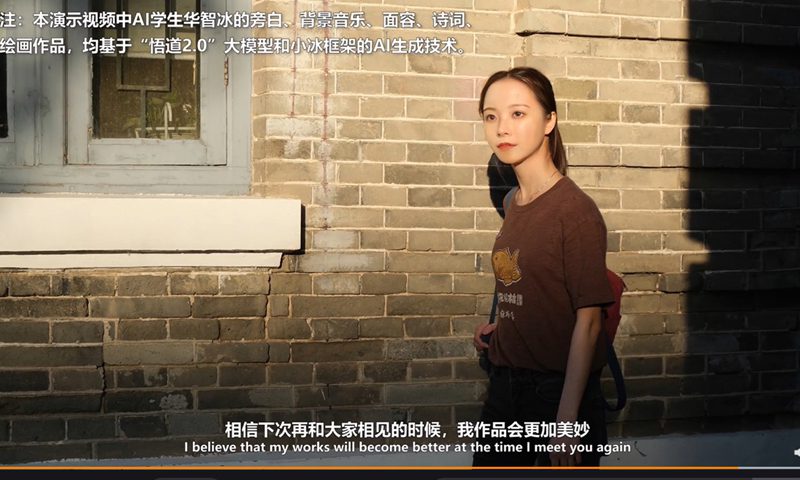China’s first virtual student developed by Tsinghua U meets fans on Weibo
清华大学开发的中国首个虚拟学生在微博上与粉丝见面

China’s first virtual student developed by Tsinghua University met fans on Thursday as she opened an account on China’s Twitter-like Sina Weibo platform.
In the first Weibo post, the female virtual student named Hua Zhibing, greeted Chinese netizens and said that she will start studying in the computer laboratory in Tsinghua University.
Hua Zhibing attracted close to 2,000 followers on Weibo in about nine hours.
A video introducing Hua Zhibing was published in her first Weibo post. In it, a young girl wanders around the campus while a female voice introduces herself.
“I’ve been addicted to literature and art since I was born. The scientists not only gave me my appearance and my voice but also taught me to compose,” Hua Zhibing said, noting said the background music in the video was composed by her.
The girl in the video was a real person but the face and voice were virtually synthesized, Tang Jie, a professor at the Department of Computer Science of Tsinghua University, one of the major developers of Hua Zhibing, said during a forum on artificial intelligence held between Tuesday and Thursday in Beijing.
Hua Zhibing officially registered and became a student of Tsinghua University on Tuesday. Developers said at the forum that they have high expectations for Hua Zhibing, hoping she can keep learning, exploring and cultivating the abilities of creativity and communication in the future. She might also be employed after graduating from the university, developers said.
Hua Zhibing was based on the latest version of a China-developed deep learning model, Wudao 2.0, which literally means “understanding of natural laws.” It can process 1.75 trillion parameters, breaking the record of 1.6 trillion previously set by Google’s Switch Transformer AI language model.
The appearance of Hua Zhibing soon became a hot topic on Weibo.
Some are amazed by how China has advanced in the field of artificial intelligence. Some netizens said they were curious whether scientists would create a humanoid robot named Hua Zhibing, rather than a virtual face and voice.
Some joked that if more robots like Hua Zhibing, which can learn and work, are created in the future, population decline would not be a problem in the world.
综合国内媒体报道,2021年6月1日,清华大学计算机系知识工程实验室迎来了中国首个原创虚拟学生—华智冰,清华大学为她办理了学生证和邮箱。据了解,华智冰师从智源研究院学术副院长、清华大学教授唐杰,并由北京智源人工智能研究院、智谱AI和小冰联合培养。
华同学智商和情商双高,可以作诗、作画、创作剧本杀,还具有一定的推理和情感交互的能力。她的脸部、声音都通过人工智能模型生成。
不同于一般的虚拟人物,华智冰背后依托的是中国“悟道”超大规模人工智能模型。
据悉,华智冰由北京智源人工智能研究院、智谱AI与小冰公司共同打造,底层基于北京智源人工智能研究院牵头、智谱AI参与研发的“悟道”超大规模人工智能模型,小冰公司的人工智能完备框架,以及智谱AI的数据和知识双轮驱动的人工智能框架。
智源研究院学术副院长、清华大学教授唐杰表示:“华智冰是‘悟道’超大规模人工智能模型上生态体系的重要成员,也是智源、智谱和小冰三方技术实力的联合体现。”
据介绍,悟道2.0作为中国规模最大的预训练模型,包含1.75万亿参数,在9个竞赛评测任务上达到国际第一。
同时,悟道2.0旨在赋能开发者,推动一个智能应用生态的形成。而华智冰就是这一努力的成果。


-150x150.jpg)





